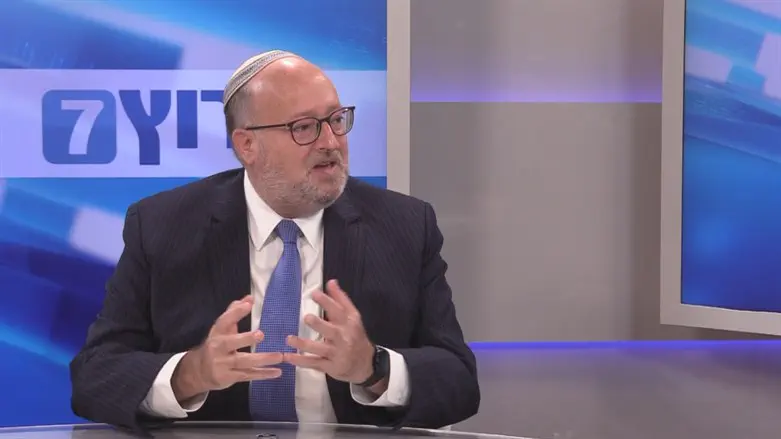
Rabbi Dr. Kenneth Brander is President and Rosh HaYeshiva of Ohr Torah Stone
The practice of reading a weekly passage from the Prophets, the haftarah, was first instituted in antiquity, during an era when persecutory laws forbade Jews from reading the Torah publicly. According to Rabbi David Abudraham, because the haftarot were originally read in place of the weekly Torah portion, the Sages selected them carefully to ensure that at least one of the central messages of each parsha would be embedded in that week’s reading.
However, beginning this week, and for the next twelve weeks, we deviate from this norm. For three weeks, in anticipation of the fast of Tisha Be’av, we will read prophecies that focus on the causes of the destruction of the Beit Hamikdash and the expulsion of the Jewish People from the Land of Israel.
Then, for seven weeks after the fast, we will continue with readings that contain messages of consolation and salvation for the Jewish people, giving voice to our forward-looking optimism and faith in a speedy and complete redemption in our own time. This in turn will be followed by two haftarot devoted to the theme of teshuva [repentance] during the High Holiday period.
When it comes to the haftarot for the three weeks building up to Tisha Be’av,the Shulchan Arukh (Orach Chaim 428:8) lists the special readings from Isaiah and Jeremiah that are commonly read today. Five hundred years earlier, however, Maimonides, in his Mishneh Torah, painted a more complicated picture. At the close of Sefer Ahava he provides a comprehensive list of all the weekly haftarot, and there he does not indicate any special readings for the three weeks. On the contrary, all the entries on his list are readings that connect to themes of the parsha.
The same holds for the Sheva Denechamta - the seven haftarot of consolation universally read on the Shabbatot following Tisha Be’av. One who consulted this list would have no inkling that special haftarot are ordinarily read during these weeks. And yet, earlier in the same volume, in Hilkhot Tefilla (13:19), he writes as follows:
It is the custom of the people on the three Sabbaths before Tisha Be’av to read haftarot of rebuke…. Similarly, it is the common custom in our cities to read the comforting prophecies of Isaiah as the haftarot from Tisha Be’av until Rosh Hashana. On the Sabbath between Rosh Hashana and Yom Kippur, we read “Shuva Yisrael” as the haftarah.
To understand the apparent contradiction in the Mishneh Torah, it is important to focus on Maimonides’ opening formulation “It is the custom of the people” [nahagu haam]. This phrase hints to us that the people themselves changed their practice from what had been previously established. The tradition of selecting special readings to befit the solemnity of the season began in the Land of Israel, where the search to find ways of mourning the loss of the Temple and Jewish sovereignty was felt most acutely.
Diaspora Jews, however, did not originally mark these weeks enveloping Tisha Be’av with haftarot devoted to contrition, comfort and making sense of these traumatic events. As time went by, however, the Jews in exile began to adopt this practice in identification with the severity of our collective loss and our hope for national redemption. The dissonance in Maimonides’ writing reflects this shift, expressing both the original custom of the diaspora Jews and the new custom they took upon themselves in solidarity with their brethren in the Land of Israel.
In today’s connected world, we are experiencing a similar exchange of ideas and themes between Israel and Diaspora Jewry. The challenges and pain of recent years - from antisemitism, national crises and war- have drawn us closer together as one people. Here in Israel, whether one is haredi, religious zionist, or celebrates Shabbat on the beaches of Tel Aviv, we face the same threats and celebrate the same miracles.
Those of us privileged to live in Israel experience Jewish identity and halakha not only in our homes or synagogues, but also in the public sphere - through language, culture, law and national life. That experience offers a spiritual and emotional dimension that is difficult to convey. Yet it is precisely in sharing those moments that we can influence and strengthen our bond with our brothers and sisters across the globe.
Jewish life outside of Israel is one of deep commitment. Yet, as with the haftarot of mourning and consolation that gradually became part of the Diaspora practice over time, there is a continuing process of connection and discovery of how the holistic messages found in Israeli Jewish life can also resonate far beyond its borders.
Like the haftarot themselves, which begin with rebuke and end with comfort , our collective Jewish story is one of shared struggle and hope. These weeks invite us into a conversation that bridges our distance with a common narrative.
Through the three haftarot of rebuke we express our vulnerability and longing for something more purposeful; and through the seven of consolation, we proclaim our collective optimism and belief that we will live to see the full redemption.
This relationship of engagement and dialogue with our family abroad, highlighted in Maimonides’ halakhic comment “nahagu haam”, represents a wondrous responsibility for us. It is up to us to demonstrate, articulate , and affirm that we are truly one nation - united by the same eternal mission, ideas and ideals, and to build a future worthy of our shared past.